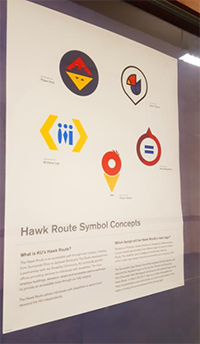Students make over HawkRoute symbol to improve visibility, heighten awareness
LAWRENCE — A little-known feature of the University of Kansas campus is getting an enhancement from students.
 HawkRoute, an accessible route that neutralizes the distinguishing hills and conventional barriers found on the KU landscape, has been available since 2012. Now, design students are working to create inclusive iconography and signage recommendations to elevate awareness of this important amenity primarily serving individuals with disabilities.
HawkRoute, an accessible route that neutralizes the distinguishing hills and conventional barriers found on the KU landscape, has been available since 2012. Now, design students are working to create inclusive iconography and signage recommendations to elevate awareness of this important amenity primarily serving individuals with disabilities.
“People reported that the current HawkRoute signs are unclear and pose different challenges depending on whether one is coming or going,” said Catherine Johnson, director of ADA Resource Center for Equity & Accessibility.
Johnson sought help from the Department of Design, and a student project and contest was developed.
“Our goal in this project is to increase visibility of this important benefit and highlight the route in a way that is both creative and inclusive for all individuals with disabilities,” she said.
The route makes use of existing sidewalks, ramps, buildings and elevators to gradually guide people from Jayhawk Boulevard to Sunnyside Avenue and back again.
About 40 undergraduate students in Associate Professor of Design Jeremy Shellhorn’s Designing Understanding course spent three weeks on the endeavor this semester. The students’ challenge was to design a symbol denoting accessibility and inclusion without relying upon the current universal symbol of accessibility. Students first acquainted themselves with HawkRoute and issues surrounding accessibility, then spent hours designing and redesigning a symbol that conveys the message “KU is accessible to all.”
“This is a service-learning opportunity to solve a real-world visual communication design problem — do some good and design something that helps somebody,” Shellhorn said. “It was a tough challenge for the students to create a visual solution that both responds to a real need and real audience, and expresses the communication goal of accessibility and inclusivity. A specific challenge we talked about a lot was how to convey those ideas to a broad audience while making sure we didn’t stereotype, misrepresent or use symbols that speak to one audience but are perhaps offensive or wrong for another audience. … This was a great reminder and experience.”
The renewed emphasis on HawkRoute is welcome. The route is seen as a unifier by individuals with disabilities and their advocates.
“Without HawkRoute, a student with a disability may feel that they cannot navigate around campus with their friends or colleagues,” said Kelsey Shinnick, graduate research assistant for the Research & Training Center on Independent Living. “They would have to take alternative forms of transportation, which may have a tendency to isolate the student. One of my favorite things about HawkRoute is … it is not only useful for students with disabilities — it is useful for all people, including parents with strollers, seniors and students with temporary orthopedic conditions.”
The project is also timely in its effort to improve accessibility on a campus that’s being transformed.
“KU has a large campus with many new buildings being added. This (growth) makes wayfinding more difficult and dynamic,” said Dot Nary, assistant research professor in the Bureau of Child Research and adviser to the AbleHawks and Allies student organization. “It is important for people, particularly people with mobility limitations, to be able to find the easiest route to be able to get where they need to go, without wasting time and energy.”
A diverse committee led by Johnson reviewed the students’ work and selected five contenders for the winning design. The finalists’ projects are on public display until March 28 in the Kansas Union, Anschutz Library, Watkins Health Center, Watson Library, and two locations in Strong Hall, outside the Academic Achievement and Access Center and the Office of Student Affairs. Provost and Executive Vice Chancellor Neeli Bendapudi will recognize the top five symbols and announce the winning design during an award reception honoring the students’ designs on March 28. KU’s ADA Resource Center for Equity and Accessibility will post the final logo on the Accessible KU website following the reception.
“This is really an exciting time at KU,” Johnson said. “The creative work of our students is improving accessibility on campus and also sending a larger message of inclusion for people of all abilities. The students will also be able to put this experience to further use in their future careers as design professionals.”
Johnson expects the new HawkRoute symbol and wayfinding signs may be updated before the start of the fall semester. Johnson envisions the new design and signs for HawkRoute will ultimately be incorporated into the Jayhawk Trail outlined in the 2014 KU Campus Master Plan.